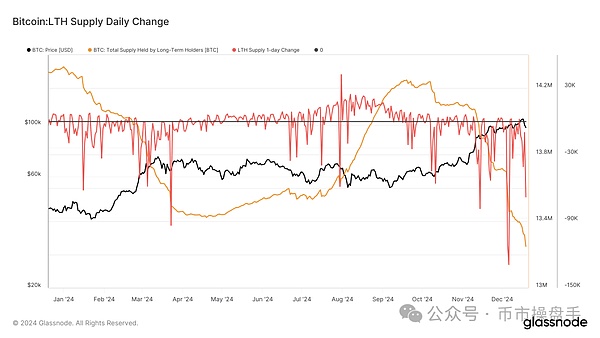
In the past week, the crypto market has experienced its largest correction since Trump won the election. Although Bitcoin's decline was only 12%, the decline of many altcoins has been cut in half, and even the gains of some altcoins in this round of market have been completely wiped out. If the reason for not being pessimistic on December 10 is that the remaining heat of the bull market is still there, then the recent decline has undoubtedly completely destroyed the confidence of bulls. This also makes more and more investors convinced that the bull market is over.
I have always emphasized that general rising prices are difficult to last. The growth in market capitalization driven by emotions will eventually be countered by the ebb of emotions. Therefore, as fast as altcoins rise, they will fall just as violently. After all, the market cannot always maintain a daily trading volume of US$540 billion, which means that shocks and differentiation are inevitable. However, the author believes that the current shock is more like a bull market shifting gears rather than the end of the bull market. There are three main reasons:
1. As of December 22, the scale of selling by long-term Bitcoin investors since September has reached 1 million, exceeding the 934,000 from March to June. However, the last time the sell-off reached this magnitude, Bitcoin saw a range-wide decline of 33%, and currently Bitcoin is only down 15% from its highs. This shows that the market capacity in this cycle is stronger and Bitcoin’s resilience has also improved significantly.
2. History On the market, whenever major positive news is released, Bitcoin will often experience a symbolic correction, creating entry opportunities for institutions. For example, after the Bitcoin ETF was approved, Bitcoin fell from $48,950 to $38,550, a drop of as much as 21%. The market's decline before Trump took office is fully consistent with this practice. Although the size of U.S. Bitcoin ETFs has surpassed gold, the allocation of Bitcoin ETFs by pension funds, listed companies, and traditional financial institutions is still far lower than that of gold ETFs. Therefore, this decline will most likely be an opportunity for institutions to increase their Bitcoin positions.
3. MSTR currently has US$7.65 billion of instant issuance (ATM) quota and US$15 billion of convertible notes quota unused, with a potential available increase of up to US$22.65 billion, and it still has the ability to launch defensive counterattacks.
However, whether from the perspective of time or space, the market adjustment is still far from over. If Bitcoin continues to test the lower limit of the range of $88,000, it may be difficult for most altcoins to hold on to the lows reached on December 20 . Even if Bitcoin reaches a bottom near $88,000, the establishment of a new trend will still require a long bottoming process. In short, investors do not need to rush to buy the bottom in this round, and the market still needs more time to digest the negative factors. p>
Currently, macro risks are still the biggest uncertainty in the market. Affected by the rebound in inflation and the imposition of tariffs, the market has generally lowered the Federal Reserve's interest rate cut expectations next year, and some Wall Street institutions have even given the start of raising interest rates in the second half of next year. forecast. As a result, the yield on the U.S. 10-year Treasury bond continues to rise against the backdrop of the Fed's interest rate cuts, exceeding the federal funds rate for the first time in the past two years. This has a significant crowding-out effect on the liquidity of risk assets.
At the same time, as U.S. bond yields soar, non-U.S. currencies are facing tremendous depreciation pressure and capital outflow pressure is intensifying. This has also contributed to rising expectations of Japanese yen interest rate hikes. Although the Bank of Japan denies the possibility of a recent interest rate hike, However, Nomura expects the Bank of Japan to raise the benchmark interest rate in March 2025, and then raise the benchmark interest rate to 1% through two interest rate hikes. The risk of the reversal of the yen carry trade has once again become the focus of the market.
However, the outbreak of macro risks is not a bad thing. According to the prediction of White House encryption director David Sacks, the crisis of the legal currency system is Bitcoin. Opportunity to become a mainstream currency
In terms of operation, as Christmas approaches, market transactions gradually become lighter. Periodic land volume and land prices may appear around Christmas. ForFor investors who are ready to buy the bottom, the leader in the segment is still a good choice. After all, the declines of SUI, AAVE, LINK and other currencies in this round of adjustment are still far lower than the average level of altcoins, and the characteristics of the strong are always strong.











